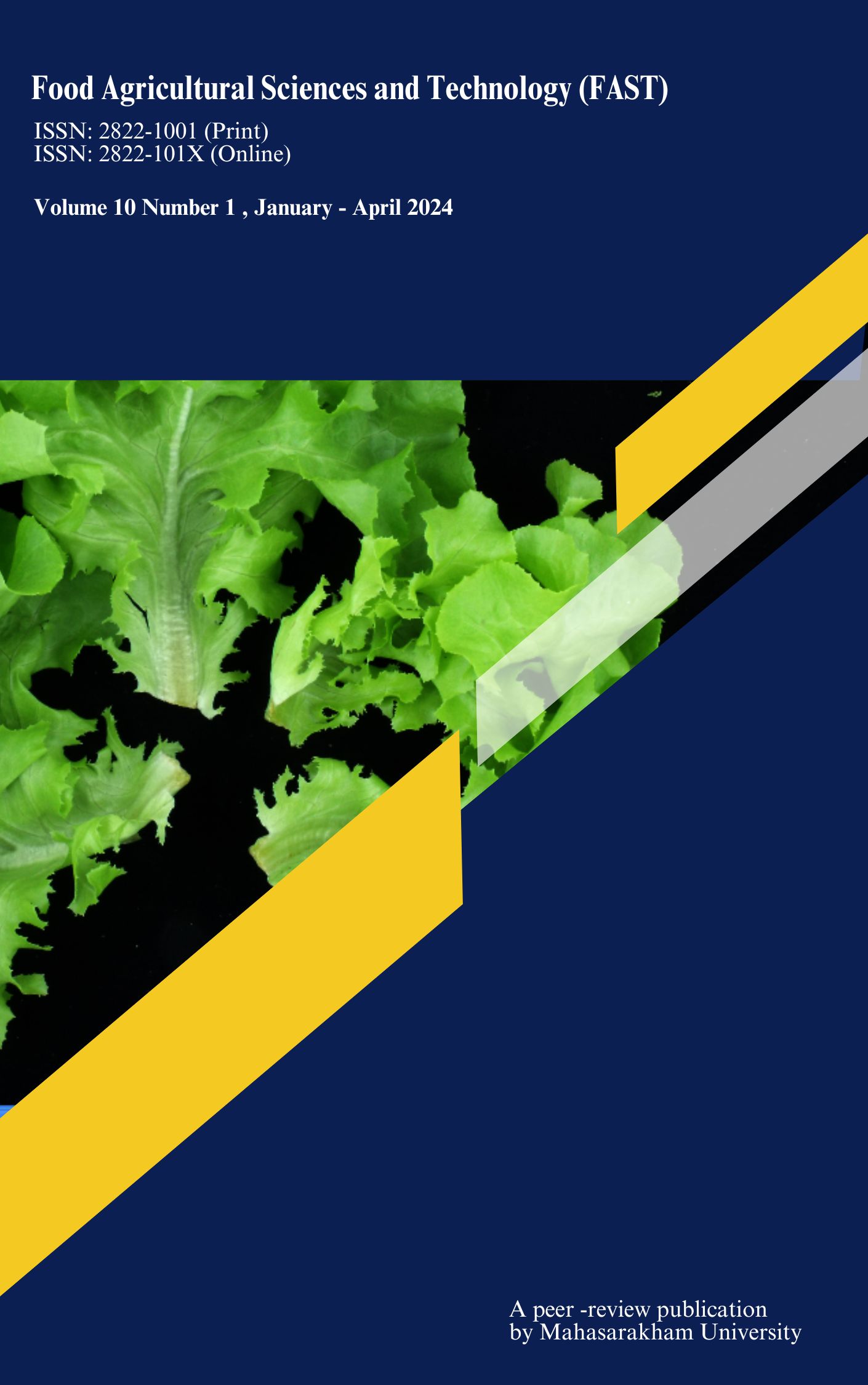Image processing algorithm for area determination of irregularity quality in leafy green salad
Keywords:
Image processing, leafy green salad, green oak, color changeAbstract
The objective of the research was to develop an image processing algorithm for analyzing the color change of leafy green salad using Green Oak as a sample. The research was divided into two parts. The initial step was to construct an image acquisition system. To provide uniform light intensity across the samples, two D65 lamps were mounted 30 cm above the samples at a 45° angle to the sample plane. The second step was to develop an image processing algorithm to analyze the color change of Green Oak salad. For analysis, the algorithm employs the H (hue angle) value. In the image of Green Oak salad, H can be indicated browning. The browning zone is indicated by a H value of 35° to 79°, and the regular color of Green Oak salad is indicated by a H value of 80° to 135°. An experiment with Green Oak salad vegetables stored at 5°, 10°, and 15° revealed that the amount of brown area in the salad vegetables was greater than 9% of the total area. Green Oak salad vegetables are irregular quality, exceeding acceptable limits.
References
Arjenaki, O., Moghaddam, P. & Motlagh, A. (2013). Online tomato sorting based on shape, maturity, size, and surface defects using machine vision. Turkish Journal of Agriculture and Forestry, 37, 62-68.
Basset, O., Buquet, B., Abouelkaram, S., Delachartre, P. & Culioli, J. (2000). Application of texture image analysis for the classification of bovine meat. Food Chemistry, 69, 437-445.
Berg, E. P., Kallel, F., Hussain, F., Miller, R. K., Ophir, J. & Kehtarnavaz, N. (1999). The use of elastography to measure quality of characteristics of pork semimembranosus muscle. Meat Science, 53, 31-35.
Briones, V. & Aguilera, J. M. (2005). Image analysis of changes in surface colour of chocolate. Food Research International, 38, 87-94.
Cernadas, E., Carrio, P. Rodrigues, P. G., Muriel, E. & Antequera, T. (2005). Analyzing magnetic resonance images of Iberian pork loin to predict its sensorial characteristics. Computer vision and Image Understanding, 98, 345-361.
Dorj, U.O., Lee, M., & Yum, S., (2017). An yield estimation in citrus orchards via fruit detection and counting using image processing. Computers and Electronics in Agriculture, 140, 103-112.
Chen, Q., Zhao, J., Fang, C.H. & Wang, D. (2007). Feasibility study on identification of green, black and Oolong teas using near-infrared reflectance spectroscopy based on support vector machine (SVM). Spectrochimica Acta Part A: Molecular and Biomolecular Spectroscopy, 66(3), 568-574.
Dubey, S.R. & Jalal, A.S. (2016). Apple disease classification using color, texture and shape features from images. Signal, Image and Video Processing, 10(5), 819-826.
Frustaci, F., Spagnolo, F., Perri, S., Cocorullo, G., & Corsonello, P. (2022). Robust and high-performance machine vision system for automatic quality inspection in assembly processeS. Sensors, 22(8), 2839.
Leemans, V., Magein, H. & Destain, M.F. (1998). Defects segmentation on golden delicious apples by using colour machine vision. Computers and Electronics in Agriculture, 20, 117-130.
Li, D., Shen, M., Li, D. & Yu, X., (2017). Green apple recognition method based on combination of texture and shape features. Internationalconference Mechatronics Automation (pp. 264-269).
Lin, Y., Ma, J., Wang, Q., & Sun, D. W. (2023). Applications of machine learning techniques for enhancing nondestructive food quality and safety detection. Critical Reviews in Food Science and Nutrition, 63(12), 1649-1669.
Pereira, L.F.S, Junior, S.B., Valous, N.A. & Barbin, D.F. (2018). Predicting the ripening of papaya fruit with digital imaging and random forests. Computers and Electronics in Agriculture, 145, 76-82.
Stratton, A. E., Finley, J. W., Gustafson, D. I., Mitcham, E. J., Myers, S. S., Naylor, R. L., & Palm, C. A. (2021). Mitigating sustainability tradeoffs as global fruit and vegetable systems expand to meet dietary recommendations. Environmental Research Letters, 16(5), 055010.
U.S. Department of Agriculture. (2020). Statistics by subject. National statistics for lettuce. https://www. nass.usda.gov/Statistics_by_Subject.
U.S. Department of Agriculture. (2019). Food availability (per capita) data system, vegetable (fresh). https:// www.ers.usda.gov/data-products/ foodavailability-per-capita-datasystem.
Vijayarekha, K. (2012). Machine vision application for food quality: A review. Research Journal of Applied Sciences, Engineering and Technology, 4(24), 5453-5458.
Volkava, K., & Mickiewicz, B. (2022). Main trends of dynamic development of the vegetable products and fruits global market. VUZF Review, 7(3), 78.
Yang, Q. & Marchant, J.A (1995). Accurate blemish detection with active contour models. Computers and Electronics in Agriculture, 14, 77-89.
Zhou, T., Harrison, A.D., McKellar, R., Young, J.C., Odumeru, J., Piyasena, P. & Lu, X., Mercer, D.G., & Karr, S. (2004). Determination of acceptability and shelf life of ready-to-use lettuce by digital image analysis. Food Research International, 37, 875-881.
Downloads
Published
How to Cite
Issue
Section
License
Copyright (c) 2023 Food Agricultural Sciences and Technology

This work is licensed under a Creative Commons Attribution-NoDerivatives 4.0 International License.








